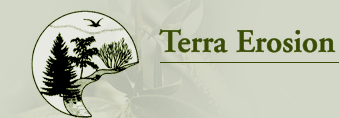Stormwater
Outfall Rehabilitation
OUTFALL
56
Location:
Dawson
Park, along bank of North Saskatchewan River in Edmonton,
Alberta
Client:
City
of Edmonton
Objective:
To
protect the infrastructure of storm water outfall 56
by stabilizing the riverbank using vegetated riprap.
Creation of fish and wildlife habitat values through
incorporation of vegetation within the riprap using
soil bioengineering techniques. Vegetation establishment
on slopes/banks surrounding area of riprap installation.
In
the spring of 2007 Stantec Consulting contacted Terra
Erosion Control (TEC) regarding riverbank erosion problems
at storm water outfall #56, which discharges into the
North Saskatchewan River. The riverbank erosion appeared
to have been caused by fluctuating water levels and
the melting of the ice on the river over years, which
undermined the toe of the slope on either side of the
outfall structure resulting in shallow slope failures.
In
June of 2007 TEC was retained to carry out a field assessment
and develop a rehabilitation prescription and cost estimate
to implement the work. The developed prescription incorporated
a vegetative riprap application designed by TEC. This
vegetated riprap application incorporated the use of
long live cuttings into the original riprap design developed
by Stantec Consulting. Soil bioengineering treatments
such as brush layers and contour fascines were also
prescribed for the bank/slope surrounding the riprap.
The
work was implemented in September and October of 2007,
TEC working in conjunction with Kitchton Contracting
of Edmonton. Soil bioengineering structures were constructed
with locally harvested live cuttings of willow (Salix
bebbiana/exigua/scouleriana) , black cottonwood
(Populus balsamifera ssp. trichocarpa) and
red-osier dogwood (Cornus stolonifera).
Live
cuttings were installed within the riprap concurrent
with rock placement using a walking excavator or spyder
hoe. Wooden boards/plywood sheets were used to protect
the cuttings as riprap was placed on the slope.
In
accordance with the Department of Fisheries and Oceans
regulations a work area was enclosed using a turbidity
curtain in front of the project area, in order to reduce
sediment delivery to the river. Straw wattles and silt
fencing were also installed on the slope to act as sediment
traps.
Brush
layers were installed on the slope adjacent to the riprap
with the assistance of an excavator; contour fascines
were also installed on the slope manually. Compost was
then placed over the disturbed soil portion of the project
areas and seeded using a native grass mix and planted
with native rose seedlings (Rosa acicularis).
The
site was watered by the City of Edmonton during the
summer of 2008. Photos taken by Stantec Consulting in
September 2008 and by the City of Edmonton in October
2008 are shown below. Overall, the vegetated riprap was growing well at this time. The brush layers and
contour fascines installed on the slope adjacent to
the riprap showed only fair survival.
|

